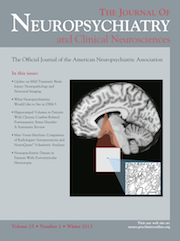A Case of Schizophrenia With Meige Syndrome Induced by Perospirone Successfully Treated With Biperiden
To the Editor: Meige syndrome is a focal dystonia involving symmetrical blepharospasm and oromandibular dystonia. The typical symptom is difficulty in keeping the eyelids open. This syndrome has been reported to be induced by several atypical antipsychotics, including risperidone, olanzapine, quetiapine, and aripiprazole.1–4 Here, we report a case of Meige syndrome emerging with an atypical antipsychotic, perospirone, which was successfully treated with biperiden. To our knowledge, this is the first report of Meige syndrome induced by perospirone.
Case Report
“Ms. A,” a 35-year-old woman, fulfilled the DSM-IV-TR criteria for schizophrenia, paranoid type. There was no family history of neurological or medical disorders. Her illness began at age 21 years. Her initial symptoms were characterized by auditory hallucinations and persecutory delusion. She had been treated with several antipsychotics, including risperidone, sulpiride, quetiapine, and perospirone. She started receiving perospirone (8 mg) at age 26 years, and had been prescribed perospirone and one/two benzodiazepines since age 27 years. From age 29 years, perospirone dosage was generally 32 mg. After being on this dose for 1½ years, she exhibited cervical dystonia. Perospirone was then decreased (to 12 mg), and biperiden (6 mg) was added. However, since her dystonia was not improved, we additionally prescribed clonazepam (1 mg) and diazepam (4 mg). Consequently, her dystonia disappeared after 1 month. Over the following year, perospirone was increased (to 32 mg), biperiden was decreased (to 2 mg), and clonazepam and diazepam were stopped. After maintaining this dosage for 2 months, she developed symmetrical oromandibular dystonia. Perospirone was decreased (to 24 mg); accordingly, her dystonia was improved, although it did not completely disappear. For the next 2½ years, she showed no relapse of psychotic symptoms and marked side effects during perospirone monotherapy (24 mg; no biperiden). However, she exhibited symmetrical mild oromandibular dystonia and blepharospasm, and had difficulty keeping both eyes open. She had to discontinue vision-dependent tasks like watching TV, cooking, and walking. No abnormal movements were observed in other areas of her body. We added biperiden (3 mg), and these symptoms were almost gone 1 month later. Although her abnormal facial movements did not completely disappear, she showed no difficulties in managing activities of daily living. To date, she has had no exacerbation of psychotic symptoms and remarkable side effects for 1 year with perospirone (24mg) and biperiden (3 mg).
Discussion
Perospirone is an atypical antipsychotic drug, and has been used only in Japan for 11 years. It has a high affinity for dopamine D2 and serotonin 5-HT2A receptors.5 Meige syndrome is one of the tardive dystonia that appears after long-term use of antipsychotic drugs.1,4 Umene-Nakano et al. (2011)4 recently presented a case of Meige syndrome induced by aripiprazole successfully treated with perospirone. However, perospirone induced Meige syndrome in this case. Anticholinergics have been well known to improve dystonia. This report suggests that Meige syndrome can occur in the long-term use of perospirone, and the addition of anticholinergic drugs may be useful for ameliorating Meige syndrome in antipsychotic therapy.
1 : Meige’s syndrome associated with risperidone therapy. Am J Psychiatry 2000; 157:149Crossref, Medline, Google Scholar
2 : A case of Meige dystonia induced by short-term quetiapine treatment. Hum Psychopharmacol 2002; 17:197Crossref, Medline, Google Scholar
3 : Olanzapine induced acute Meige’s syndrome. J Neuropsychiatry Clin Neurosci 2009; 21:225Link, Google Scholar
4 : A case of schizophrenia with Meige syndrome induced by long-term aripiprazole successfully treated with perospirone. Prog Neuropsychopharmacol Biol Psychiatry 2011; 35:273Crossref, Medline, Google Scholar
5 : Perospirone. CNS Drugs 2001; 15:329–337, discussion 338Crossref, Medline, Google Scholar



